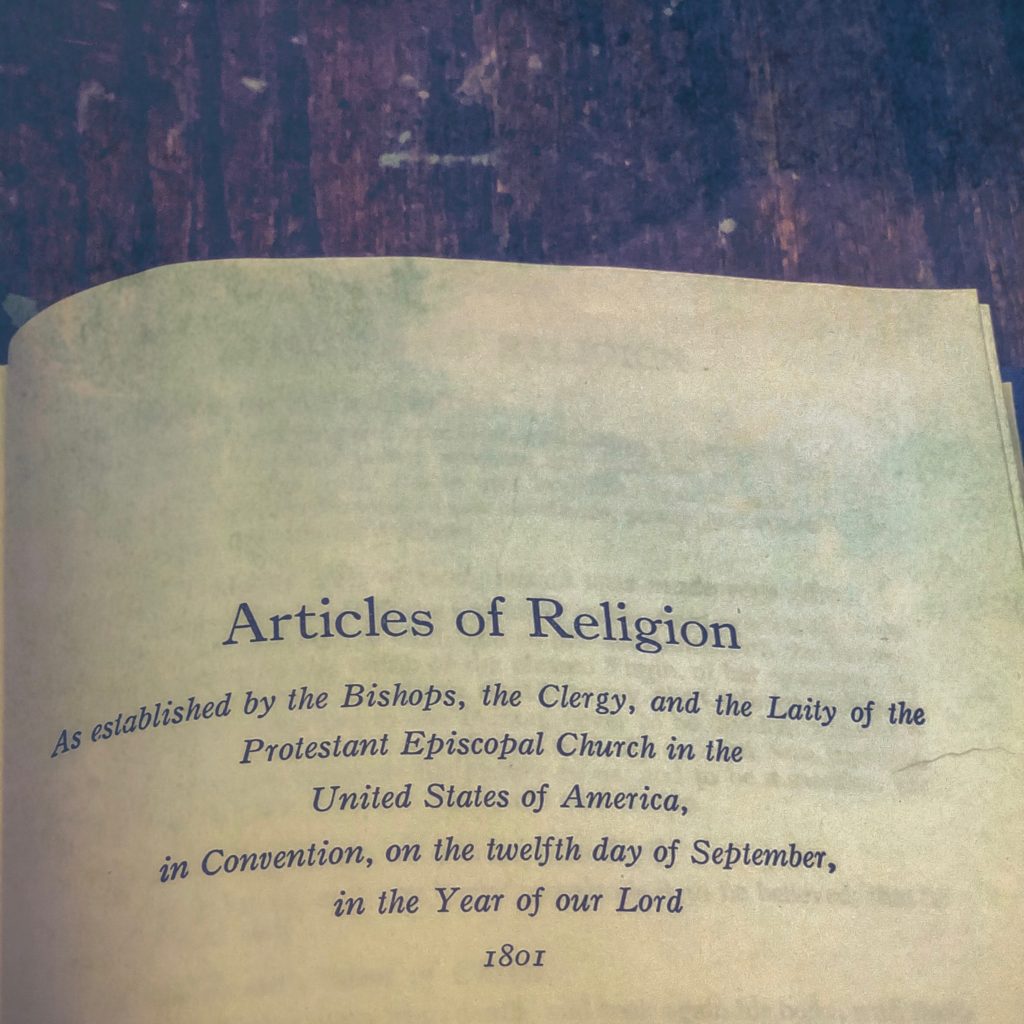
Bishops, Priests, and Deacons, are not commanded by God’s Law, either to vow the estate of single life, or to abstain from marriage: therefore it is lawful for them, as for all other Christian men, to marry at their own discretion, as they shall judge the same to serve better to godliness.
by the Rev. Ian Lasch
The History
While clerical celibacy does have a long history in the Western Church, it was not (or at least not uniformly) the practice of the earliest Christian clergy. Debates about whether or not clergy could (or should) marry were ongoing for the first four or five centuries. The scriptural support for it is certainly something less than conclusive, based primarily upon Jesus’ insistence that not marrying is better than divorce (in Matt. 19:3-12) and some of Paul’s urgings that it is better to be unwed rather than distracted by passions or by concern for one’s family (1 Cor. 7:8-9; 32-35). (Interestingly, of course, Paul seems very careful to qualify this recommendation, making clear that it is not a requirement.) There is additionally a set of suggested qualities or virtues for bishops in 1 Tim. 3:1-3 that has been translated various ways, including sometimes (such as in the Didascalia Apostolorum) as “chaste.” However, it’s difficult to see in this a prescription for even unmarried bishops, since the second quality in this list for bishops is “married only once,” and the passage goes on to recommend that bishops’ children be of the ruly, rather than unruly, variety. Scripture also makes it clear that Peter was married.
These scriptural passages, along with some additional reflections on sexual ethics from the early Church Fathers (among them Tertullian, Jerome, Augustine, and Ambrose), are eventually turned into a hard and fast rule, though it’s possible to trace its development throughout history. The earliest actual canon regarding celibacy, for example, coming from the Council of Elvira (c. 305), does not preclude married clergy, but rather prescribes a lack of sexual relations with their wives on the part of those married men who become clergy. Presumably, this would be a difficult canon to enforce, which could explain why the requirement eventually becomes more stringent. In the Council of Nicea, clergy are prohibited from cohabitating with subintroducta, a term used to refer to unwed women who were spiritual companions. Interestingly, exception is made for family members or “such persons as are beyond all suspicion”, a phrase that would seem to make it clear that the concern was in having clergy refrain from sexual relations with these subintroducta. There is, additionally, a (possibly apocryphal) story from Nicea of a Bishop Paphnutius giving an impassioned plea not to require celibacy on the part of priests and deacons.
The delightfully named Quinisext Council, or Council in Trullo (692), condemns the extant practice among some African bishops of continuing to live with their wives; a practice which it considers to be scandalous. It immediately goes on to say, however, that presbyters, deacons, and subdeacons should also no longer live with their wives, but should continue marital relations with them at convenient times, except at such times as they are expected to serve at the altar and handle the Holy Mysteries, even suggesting than anyone seeking to prevent such marital relations be deposed. (Rome, of course, does not recognize this Council.)
The question of clerical celibacy was still arguably not completely settled, even in Rome, by the time of the First and Second Lateran Councils, since they saw the need to explicitly forbid cohabitation with wives in the case of the first, and declare marriages taking place after ordination to be void in the case of the second. The latter position is once again reiterated at the Council of Trent in 1549. It is interesting to note that even Rome has nowhere made it explicit that only the unwed are to be ordained.
And of course, we must mention that while the principle that clergy ought to remain celibate was already in existence in his time, it ends up being bolstered a good bit in current Roman Catholic thought by none other than Thomas Aquinas, surprising no one. For Thomas, of course, it is a matter of virtue, and more specifically the virtue of continence. Thomas breaks from Aristotle in his discussion of continence: whereas Aristotle considers continence to be related to virtue, in that it is the resisting of evil desires, Thomas instead sees continence as “abstention from all venereal pleasure,” and thus just as much a virtue as virginity is (ST, II-II Q155 A1). There is not time or room to completely solve the question of clerical celibacy in relation to the virtues, particularly given the fluctuation of associated terminology over the years, but it is nevertheless important to note that Thomas gives significant fodder to the Roman Catholic requirement of abstinence on the part of clergy.
The Reformers, while likely not unaware of at least a significant portion of this history, nevertheless ultimately came to reject it. Which brings us back to…
The Article
Of the various forms that the Thirty-Nine Articles take, Article XXXII falls into the category of those that are most clearly a repudiation of Roman Catholic practice at the time (and since). It is also one small foray into the fraught topic of Christian sexual ethics, so we should be careful here about what the Article is and is not saying. While some of the other Articles that reject Roman Catholic teaching are more sweeping in their condemnation of certain “Romish doctrines,” Article XXXII is clearly not intended to say that clerical celibacy is “a fond thing, vainly invented” (cf. Article XXII). It doesn’t seek to prescribe marriage for all clergy, nor to say that sexual ethics are unimportant. It simply rejects clerical celibacy as a requirement, saying that the reasons given for the practice are ultimately unconvincing. Article XXXII was something of a shift even for England, as Article III of the 1539 Six Articles originally affirmed clerical celibacy in the English Church, from passage until repeal in 1547.
It sounds strange, perhaps, to modern ears that so much of the history of the Western Church was committed to clerical abstinence from intercourse even while allowing marriages (and sometimes even cohabitation) to continue. It is possible, in the wake of the sexual revolution, to view a concern with abstinence as backward or antiquated or (if you’ll forgive the completely anachronistic misnomer) joylessly puritanical.
It is frequent to hear calls lately for the Roman Catholic Church to abolish the requirement for clerical celibacy as a way of reforming that institution and of addressing the scandal of widespread sexual abuse. But clerical celibacy isn’t entirely unreasonable, and clerical marriage is not simply a means to an end. In fact, clerical celibacy arose out of a sincere concern with virtuous living, especially for those who were leading and serving as an example to a congregation. It sought to balance the concerns of doing right by one’s spouse with a need to take sexual ethics seriously, and the specific dangers that sexual temptation and unhealthy attitudes toward sexuality can present. What’s more, the Thirty-Nine Articles had no intention of saying that we should no longer concern ourselves with such things as sexual ethics. They simply held that the scriptural case for clerical celibacy was unconvincing, and that while celibacy may in fact be ideal for some clerics, there is not enough evidence to believe it is desirable for all. Far from simply permitting or prescribing a position, Article XXXII seems to take for granted the practice of discernment on the part of the individual cleric as to what style of life, married or celibate, is most likely to serve them in their pursuit of godliness.
In some sense, then, rather than dictating a position to be accepted, Article XXXII dictates a posture to be assumed – that of prayerful discernment of God’s will, and of contemplative self-awareness for what is most conducive to one’s own growth into the full stature of Christ.
The Rev. Ian Lasch is Rector of Grace Episcopal Church in Jefferson City, MO, and co-host of the Rite and Musical podcast.
